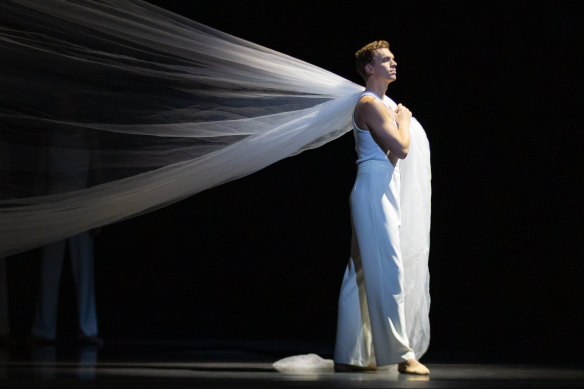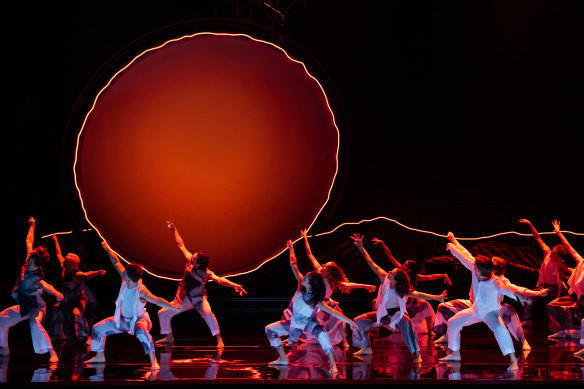Australian Ballet dancers to take first industrial action in 42 years
By Karl Quinn
Dancers at the Australian Ballet are planning to stage their first stop-work industrial action in more than 40 years on Friday night, as a campaign over pay negotiations heats up.
The performers will “hold the curtain” at the company’s performance of Identity in Melbourne, delaying the start of the two-work original program that debuted in Sydney earlier this year by around 15 minutes.

Hold the curtain: Adam Bull in the Paragon section of Identity, which will be interrupted by industrial action on Friday.Credit: Rainee Lanty
In response, the company has cancelled a one-off performance slated for the end of Friday’s show in which an eight-minute work from an emerging choreographer, featuring six dancers, was to have been presented under the Body Torque Up Late banner, a move dancers have labelled punitive.
While it might seem a particularly mild form of protest, the 15-minute delay is the most serious moment of industrial action the dancers have staged since they went on strike, twice, in 1981 after eight of the company’s lead dancers were offer reduced conditions of employment (as soloists rather than principals) for the 1982 season. On that occasion, the dancers cancelled a performance of The Three Musketeers, and ultimately went on strike for 26 days.
As part of this latest campaign, audience members for the performance – which includes Paragon, a work celebrating the company’s 60-year history, with a cast packed full of alumni including David McAllister, Fiona Tonkin, Stephen Heathcote and Lucinda Dunn – will be presented with material explaining the dancers’ position and urging them to write to the company in support of the artists.
Paragon will mark the swansong of principal dancer Adam Bull, who is retiring after 22 years with the company.
The key issue at stake in this dispute is a clause in the existing enterprise bargaining agreement under which the company agrees to top up dancers’ salaries if the pay rise falls short of CPI. The Australian Ballet is seeking to have that clause struck out, a move the dancers are vigorously resisting.

Australian Ballet’s Identity double bill is about community and connection.Credit: Daniel Boud
Under the terms of the last three-year agreement, which expired on January 31, the dancers were to receive a 5 per cent increase, in two tranches. But COVID shutdowns played havoc with that, with dancers taking pay cuts in 2020 before agreeing to a pay freeze in 2021.
Under the current rates of pay, most dancers in the country’s leading ballet company earn less than $80,000 per annum, with base rates climbing to just under $100,000 for a senior dancer and a little over $150,000 for a principal.
Negotiations over the new deal began last September, and in February, with the annual inflation rate running at more than 7 per cent, the company agreed to bolster dancers’ salaries by an additional 4.3 per cent under the “catch-up” provisions. The company also offered dancers an increase for the remainder of 2023 of just 1 per cent.
“We have such love and respect for our careers and the art form, and this has not been an easy decision,” said one dancer, who spoke on the condition of anonymity, of the decision to take industrial action. “Our careers are important to us, and they are quite short, but the dancers who came before us fought really hard for our conditions, and it’s our responsibility now to continue to maintain them.”
In a letter sent to subscribers on June 9, the company presented the top-up – which by its nature is offered retrospectively – as part of the pay increase that had been offered to dancers under the new, yet-to-be-agreed three-year deal, which will run until 2026.
“Over a three-year period, our dancers would receive a minimum 11.3 per cent salary increase, with potential for further increases under a capped CPI clause offer,” the letter, signed by artistic director David Hallberg and executive director Lissa Twomey, said.
“This proposal is more generous than recent wage offers or finalised agreements in peer dance organisations, and it comes at a challenging financial time for our company with the closure of our home theatre in Melbourne from 2024 to 2026.”
The MEAA, the union representing the dancers, insists the company is being misleading in its statements, as the offer on the table is for an increase of 7 per cent over three years – 1 per cent in 2023, 3.5 per cent in 2024, and 2.5 per cent in 2025 – with the additional 4.3 per cent being attributable to the cost-of-living increase mandated by the prior agreement, which has now expired.
The Australian Ballet has also proposed that cost-of-living bump be capped at 0.5 per cent per annum over the next three years, before being phased out at the end of the new agreement.
Contact the author at kquinn@theage.com.au, follow him on Facebook at karlquinnjournalist and on Twitter @karlkwin, and read more of his work here.
Find out the next TV, streaming series and movies to add to your must-sees. Get The Watchlist delivered every Thursday.